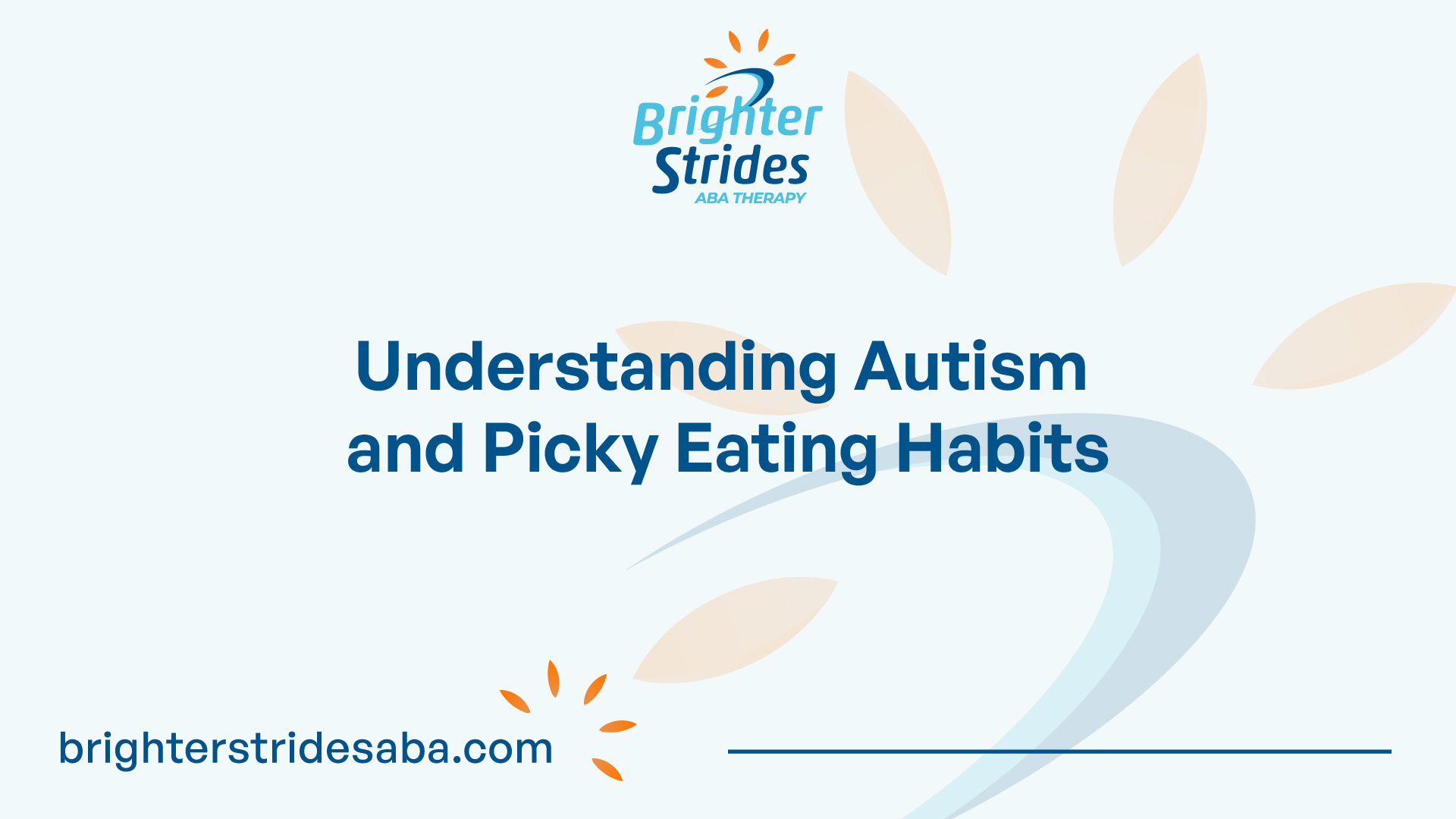Understanding Picky Eating in Autism
Picky eating is a common challenge for children on the autism spectrum, making it difficult for them to consume a varied and balanced diet and causing conflicts during mealtime. Understanding the factors that contribute to picky eating in autism is essential for developing effective strategies to address this issue. Two key aspects to consider are the challenges associated with eating in autism and the sensory factors that influence picky eating behaviors.

Challenges with Eating in Autism
Children with autism often face difficulties when it comes to eating. One of the main issues they may experience is a preference for specific textures in their mouth, such as crunchy or soft foods. Some children with autism may have weak jaw muscles, making it unpleasant for them to consume chewier foods. These challenges can limit the variety of foods they are willing to eat, leading to a restricted diet.
In addition to texture preferences, children with autism may also struggle with sitting still and behaving appropriately during mealtimes. Their difficulties with self-regulation and sensory processing can make it challenging for them to engage in the expected behaviors at the table.
Sensory Factors in Picky Eating
Sensory sensitivities play a significant role in picky eating behaviors among children with autism. They may have heightened sensitivity to certain textures, tastes, smells, or appearances of food. These sensitivities can make it challenging for them to tolerate certain foods and may lead to a limited range of acceptable food choices. Sensory factors such as tactile defensiveness, oral defensiveness, and sensory over-responsivity can contribute to their selective eating habits.
Some children with autism exhibit rigid thinking and a strong preference for routine, which can also contribute to picky eating behaviors. They may struggle with changes in their eating environment or have a limited list of preferred foods, resulting in a repetitive and restricted diet.
Understanding the challenges associated with eating in autism, as well as the sensory factors that influence picky eating behaviors, can help caregivers and professionals develop effective strategies to address these issues. By taking into account the specific needs and sensitivities of children with autism, it becomes possible to create a supportive and accommodating environment that promotes a healthier relationship with food.
Strategies to Address Picky Eating
Addressing picky eating habits in individuals with autism requires a strategic approach that takes into consideration their unique challenges and sensory sensitivities. By setting goals, utilizing techniques to expand food choices, and managing mealtime behavior, it is possible to make progress and foster healthier eating habits.
Setting Goals for Picky Eaters
To help a child with autism become less picky about eating, it is important to establish clear goals that are specific and achievable. One approach is to choose a single goal, such as increasing the number of foods they will eat, the amount they eat, or the duration of time they sit at the table. It is crucial that everyone involved in the child’s life, both at home and at school, is aware of the goal.
By focusing on a specific goal, it becomes easier to track progress and celebrate small victories along the way. This approach helps to create a supportive and consistent environment that encourages the child to explore new foods and expand their palate.
Techniques for Expanding Food Choices
Expanding the food choices of picky eaters with autism requires a patient and gradual approach. Techniques recommended by experts include ruling out any underlying medical issues, staying calm during mealtime, taking small steps towards tasting new foods, paying attention to textures, and engaging in playful interactions with unfamiliar foods.
Gradual exposure to new foods can be effective in expanding the variety of foods a child with autism is willing to eat. Introducing new foods alongside familiar and preferred foods can help build acceptance and reduce anxiety. It is important to be patient and avoid pressuring the child to eat new foods, as this can lead to resistance.
Offering choices and control during mealtime can also be beneficial. Allowing the child to participate in meal planning or food preparation can increase their engagement and willingness to try new foods. Building positive associations with mealtime experiences can help create a more enjoyable environment and foster a healthier relationship with food.
Managing Mealtime Behavior
Addressing mealtime behavior is crucial in creating a positive and supportive eating environment for individuals with autism. Strategies for managing mealtime behavior include prioritizing goals, starting small with baby steps, avoiding pushing for too much too soon, and providing ample praise for progress. Consistency, persistence, and patience are key when implementing these strategies.
Creating a structured and predictable mealtime routine can help reduce anxiety and make the experience more comfortable for the individual with autism. Clear communication and visual supports, such as visual schedules or social stories, can aid in understanding expectations and alleviate any confusion or stress.
An interdisciplinary approach involving professionals such as dietitians, occupational therapists, and behavioral psychologists can provide comprehensive support for addressing food selectivity and sensory sensitivity in individuals with autism. These professionals can provide guidance on modifying the sensory characteristics of food, offering appropriate eating utensils, and incorporating supportive behavioral interventions. This approach can enhance nutrition, reduce family stress during mealtimes, and promote positive eating habits.
By implementing these strategies and techniques, individuals with autism and picky eating habits can be supported in expanding their food choices, improving their nutrition, and promoting positive mealtime experiences.
Medical Considerations for Picky Eating
When addressing picky eating in individuals with autism, it is important to consider any underlying medical issues that may contribute to their selective eating habits. By ruling out these issues and addressing gastrointestinal distress, we can better support individuals with autism in their eating habits.
Ruling Out Underlying Medical Issues
Children on the autism spectrum often face challenges with eating, leading to limited food choices and conflicts during mealtime [1]. Before addressing picky eating behaviors, it is essential to rule out any underlying medical issues that may be causing or exacerbating these challenges. Some children with autism may experience gastrointestinal distress from certain foods, leading them to refuse food altogether.
To determine if there are any medical concerns, it is crucial to consult with a healthcare professional, such as a doctor or pediatrician. They can assess the child’s overall health and conduct any necessary medical tests to identify potential gastrointestinal issues or other medical conditions that may impact their eating habits. By ruling out these underlying medical issues, we can then focus on developing strategies to address picky eating behaviors effectively.
Addressing Gastrointestinal Distress
Gastrointestinal distress can be a significant factor contributing to picky eating in children with autism. Certain foods may cause discomfort, pain, or digestive issues, leading to the child’s refusal to eat them. It is crucial to identify and address these issues to support the child’s overall well-being and expand their food choices.
To address gastrointestinal distress, it is recommended to work closely with healthcare professionals, such as gastroenterologists or registered dietitians specializing in autism. They can provide guidance on identifying trigger foods and developing an appropriate dietary plan that suits the child’s nutritional needs while considering any sensitivities or allergies they may have. Implementing an individualized diet that takes into account the child’s specific gastrointestinal needs can help alleviate discomfort and promote a more positive relationship with food.
In addition to dietary modifications, other strategies, such as providing appropriate eating utensils and incorporating supportive behavioral interventions, can be beneficial in addressing gastrointestinal distress in individuals with autism [3]. An interdisciplinary approach involving healthcare professionals from various disciplines, including dietitians, occupational therapists, and behavioral psychologists, can provide comprehensive support and guidance in addressing both the medical and behavioral aspects of picky eating in children with autism.
By ruling out underlying medical issues and addressing gastrointestinal distress, we can better understand and support individuals with autism in their picky eating habits, ensuring their overall health and well-being.
Support and Resources for Picky Eating in Autism
When it comes to addressing picky eating in individuals with autism, it’s important to have access to support and resources that can provide guidance and assistance. In this section, we will explore some valuable sources of support for picky eating in autism, including Autism Speaks, expert strategies, and the importance of an interdisciplinary approach.
Autism Speaks and Research Funding
Autism Speaks, a leading autism advocacy organization, plays a crucial role in providing support and resources for individuals with autism and their families. In their commitment to understanding the connection between autism and picky eating, Autism Speaks is actively funding research projects focused on expanding food choices and addressing underlying factors such as anxiety, inflexibility, and sensory issues.
By funding research in this area, Autism Speaks aims to increase our understanding of picky eating in autism and develop effective strategies to address it. The organization’s dedication to ongoing research ensures that individuals with autism and their families have access to the latest information and advancements in the field.
Expert Strategies for Picky Eating
Expert strategies can provide valuable insights and recommendations for addressing picky eating in individuals with autism. One such expert, psychologist Emily Kuschner, PhD, of the Children’s Hospital of Philadelphia (CHOP), has recommended specific strategies to gently expand the diet of picky eaters on the autism spectrum.
Some of the strategies suggested by Dr. Kuschner include:
- Ruling out any underlying medical problems that may contribute to picky eating.
- Staying calm and patient during mealtimes to create a positive environment.
- Taking small steps toward tasting new foods, gradually introducing them into the diet.
- Tuning into textures of foods and exploring different sensory experiences.
- Encouraging play with new foods to increase familiarity and comfort.
- Offering choices and control to empower the individual in their food selection.
- Being mindful and cautious with the use of rewards to avoid reinforcing picky eating habits.
These expert strategies can serve as a helpful starting point for individuals and families seeking guidance on expanding food choices and addressing picky eating habits in autism.
Importance of an Interdisciplinary Approach
Addressing picky eating in individuals with autism often requires an interdisciplinary approach that involves professionals from various fields. This approach recognizes that picky eating can be influenced by multiple factors, including sensory sensitivity and behavioral issues.
Incorporating the expertise of dietitians, occupational therapists, and behavioral psychologists can help develop comprehensive strategies to address food selectivity and sensory sensitivity in individuals with autism spectrum disorders (ASDs). This multidisciplinary approach can involve modifying the sensory characteristics of food, providing appropriate eating utensils, and incorporating supportive behavioral interventions.
By bringing together professionals from different disciplines, this approach aims to enhance nutrition, reduce family stress at mealtimes, and promote a positive eating experience for individuals with autism.
Accessing support and resources from organizations like Autism Speaks, implementing expert strategies, and embracing an interdisciplinary approach can make a significant difference in addressing picky eating habits in individuals with autism. By utilizing these valuable tools, individuals and families can navigate the challenges of picky eating, promote a healthy relationship with food, and ensure proper nutrition for individuals on the autism spectrum.
The Impact of Picky Eating in Autism
Picky eating is a common challenge faced by individuals on the autism spectrum. It can significantly impact their nutritional intake and overall health. In this section, we will explore the various ways in which picky eating can impact individuals with autism, including nutritional concerns and health complications, effects on growth and the immune system, and strategies for addressing feeding problems.
Nutritional Concerns and Health Complications
Children with autism who are picky eaters often have difficulty consuming a healthy range of foods, leading to nutritional concerns. They may have strong preferences for certain textures or consistencies of food, and weak jaw muscles that make eating chewier food unpleasant. This limited food repertoire can result in inadequate nutrition, potentially causing deficiencies in essential vitamins, minerals, and other nutrients.
Furthermore, picky eating in autism can contribute to health complications. Delayed growth and weakened immune systems are among the potential consequences of inadequate nutrient intake. It’s important to address these nutritional concerns to ensure the overall well-being of individuals with autism.
Effects on Growth and Immune System
Picky eating in autism can have a direct impact on growth and development. Children with autism may have restricted repertoires of food acceptance, sometimes limited to as few as five foods. This limited variety of food choices can lead to inadequate calorie intake and nutrient deficiencies, potentially hindering proper growth and development.
In addition, compromised nutrition due to picky eating can weaken the immune system, making individuals more susceptible to illnesses and infections. A well-balanced diet is essential for supporting a strong immune system, which is crucial for overall health and resilience.
Addressing Feeding Problems in Autism
Addressing feeding problems in individuals with autism requires an interdisciplinary approach involving various professionals, such as dietitians, occupational therapists, and behavioral psychologists. This collaborative effort helps to address the complex nature of picky eating and develop effective interventions.
Interventions may include modifying the sensory characteristics of food to accommodate sensory sensitivities, providing appropriate eating utensils, and incorporating behavioral approaches to shape acceptance of various food textures . By working together, professionals can help individuals with autism expand their food choices and develop healthier eating habits.
In conclusion, picky eating in autism can have significant impacts on nutrition, growth, and overall health. It is crucial to address these challenges through a multidisciplinary approach, considering the unique sensory sensitivities and behavioral factors associated with autism. By providing support, intervention, and guidance, we can help individuals with autism overcome picky eating habits and promote their overall well-being.
References
- https://childmind.org/article/autism-and-picky-eating/
- https://www.supportivecareaba.com/aba-therapy/autism-and-picky-eating
- https://www.ncbi.nlm.nih.gov/pmc/articles/PMC3601920/
- https://www.autismspeaks.org/expert-opinion/autism-and-food-aversions
- https://iidc.indiana.edu/irca/articles/mealtime-and-children-on-the-autism-spectrum-beyond-picky-fussy-and-fads.html
- https://www.autism360.com/eight-proven-strategies-to-address-picky-eating-among-kids-with-autism/




